News
From the Canadian tundra to Cambodian villages, engineering thesis projects developed by Harvard John A. Paulson School of Engineering and Applied Sciences (SEAS) students spanned the globe to tackle complex issues. Engineering Design Projects (ES 100), the capstone course at SEAS, challenges seniors to develop a creative project that solves a real-world engineering problem.
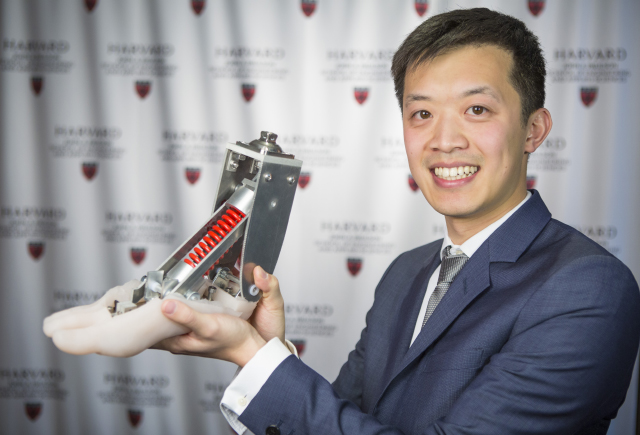
“Adaptable Passive Pediatric Lower Limb Prosthesis”
Alex Yang, S.B. ’17, engineering sciences - biomedical engineering
Advisors: Maurice Smith, Gordon McKay Professor of Bioengineering, Hugh Herr, Associate Professor of Media Arts and Sciences at MIT, and Tyler Clites Harvard-MIT Health Sciences and Technology Ph.D. candidate
In developing nations, families often struggle to afford lower limb prostheses for children, since these devices typically cost around $30,000 and must be frequently replaced as the child grows. To help solve this problem, which affects about one million children worldwide, Yang developed a passive ankle prosthesis that can be adjusted for height and mass, matching the normal gait of children, even as they grow older. The device, which utilizes springs, dampers, and cantilevers, is designed to be easy for parents to adjust at home. Because it does not require an onboard motor, the device is significantly less expensive to produce than similar systems.
“My inspiration for this project came while I was in Cambodia designing and implementing a prosthetic socket. I realized that most of our patients were adults, and I was interested in the reasons there were no children to be seen,” he said. “This project is a good example of how there are often more affordable and efficient ways to build a lot of the medical devices that we see.”
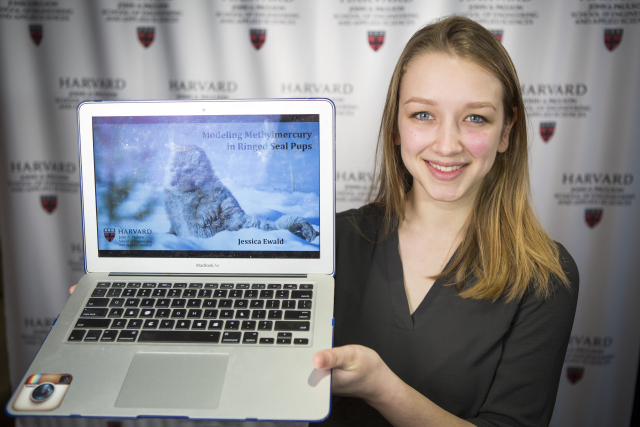
“Modeling Methylmercury in Ringed Seal Pups”
Jessica Ewald, S.B. ’17, engineering sciences – environmental sciences
Advisor: Elsie Sunderland, Thomas D. Cabot Associate Professor of Environmental Science and Engineering
The potent neurotoxin methylmercury has severe negative impacts on certain brain receptors in wildlife, but current scientific models do not address bioaccumulation differences that have been observed in marine mammals. Ewald set out to develop a model that could explain why methylmercury accumulates differently in ringed seals. Their bodies process the toxin with a much greater half-life, enabling significantly higher levels to accumulate. The model she developed using a system of differential equations shows strong evidence that younger seals’ bodies have yet to fully develop a secondary demethylization capability, so they accumulate more of the poison in certain tissues than adults. Understanding the health implications of mercury exposure for ringed seals is important because they have high cultural and nutritional significance to Inuit communities.
“Working on this project was rewarding because we were able to actually project future risks to a species of mammals that are in danger, which could raise awareness of an important environmental issue,” she said. “The seal tissue we studied was collected by groups of Inuit hunters in Canada, so it was great to see how community-based research actually works in the real world.”
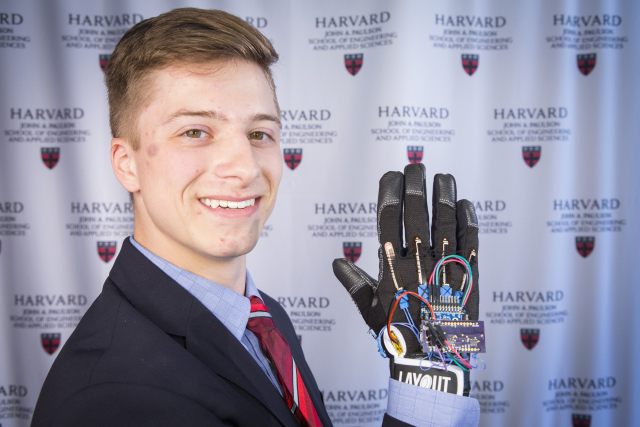
“Sensor Gloves: A Handy Solution for Improved Human-Computer Interaction with AR Devices”
Brian Krentz, S.B. ’17, electrical engineering
Advisor: Scott Kuindersma, Assistant Professor of Engineering and Computer Science
Experts estimate that about $117 billion will be invested in augmented reality and virtual reality over the next five years, leading to new 3D interfaces and hologram techniques that will require enhanced human-computer interaction tools. Most existing gesture recognition devices are expensive, fragile, bulky, and difficult to use. Krentz sought to develop a low-cost wearable glove that provides both comfort and accuracy. His device, which incorporates flex sensors for finger angle measurement and an inertial-measurement-unit to track hand orientation and motion, utilizes a trained algorithm to process raw gesture data in real-time. Ultimately, his design was able to recognize gestures with 96 percent accuracy, requires no special set up, and is easily integrated into existing AR devices.
“We’ve been moving away from the mouse-and-click, or 2D display, to more seamless three-dimensional, real-world interactions with computers,” he said. “As our technology changes to interact with the world in different ways, we want our tools to reflect that. These types of gesture recognition devise provide an easy and effective way to take natural body movements and turn those into usable interactions.”
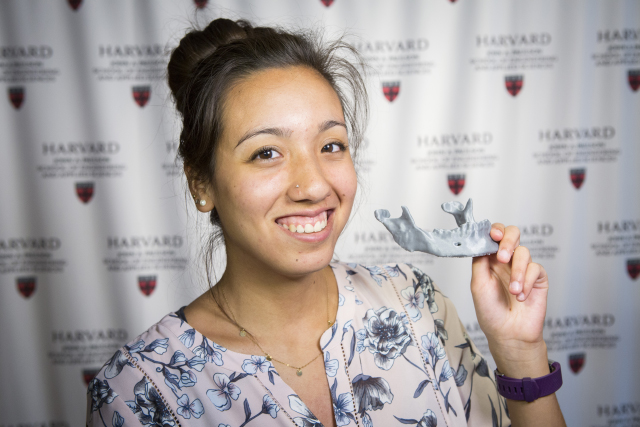
“3D Printed TMJ Disc Cartilage Grafts”
Dominique Voso, S.B. ’17, engineering sciences – bioengineering track
Advisor: Jennifer Lewis, Hansjorg Wyss Professor of Biologically Inspired Engineering
The temporomandibular joint (TMJ) in the jaw, the most used joint in the human body, has a cartilage disc that can be affected by painful disc displacement and degenerative joint diseases, which affect 5 to 12 percent of the population. Current therapies are often limited to alloplastic replacements, which can carry medical complications that make them relatively unreliable treatment options, motivating the need for a tissue engineered TMJ disc. Voso first developed a 3D-printable ink comprised of a biodegradable elastomer, a synthetic polymer with elastic qualities. She used this material to 3D print a biomimetic TMJ disc cartilage graft. Her graft, cultured with fibroblasts and stem cells, can have tunable mechanical properties that can be rapidly adjusted using 3D printing parameters, potentially creating a safer and more customizable treatment option for those who suffer from TMJ disorders.
“When I was in high school, I had a disc displacement that healed on its own, but for many people that is not the case. For those who need a disc replacement, it can be an extremely painful process. That inspired me to research a better way to help people suffering from these debilitating conditions,” she said.
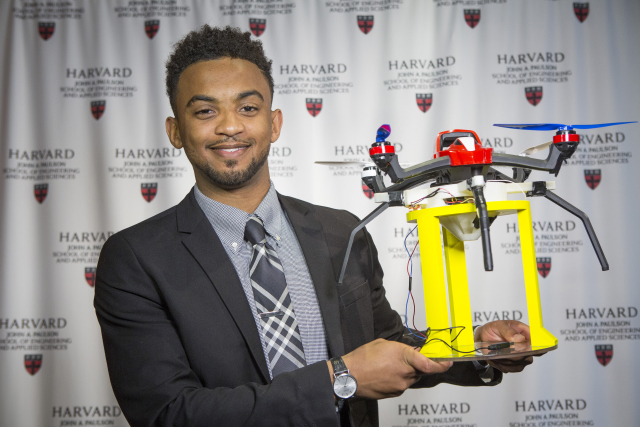
“A Portable Drone Charging Station”
Kairn Brannon, S.B. ’17, mechanical engineering
Advisor: Christopher Stubbs, Samuel C. Moncher Professor of Physics and Astronomy
More than two billion people living in rural areas in developing nations lack sufficient access to medical supplies due to inadequate road systems. Drone delivery is a potential solution for this humanitarian crisis, but the range of drones is limited by battery power. Brannon developed an affordable, lightweight drone charging station that could be easily installed in rural areas, enabling delivery drones to land and recharge batteries to continue long flights. He created a landing port that can be retrofitted onto a drone—adding only 207 grams of weight—enabling the airborne delivery device to seamlessly integrate with the charging station. The station Brannon developed has a simple, robust electrical system that is designed for connection to a solar panel, so a remote charging station would need little to no operator maintenance.
“Since this is such a low-cost system, I think this could really be a viable solution to help people living in these rural parts of developing countries,” he said. “As an engineer, I try to seek out projects that have meaning. The idea that this project could positively impact the lives of people in need around the world fueled me to keep working at it.”
Topics: Academics
Cutting-edge science delivered direct to your inbox.
Join the Harvard SEAS mailing list.
Press Contact
Adam Zewe | 617-496-5878 | azewe@seas.harvard.edu



